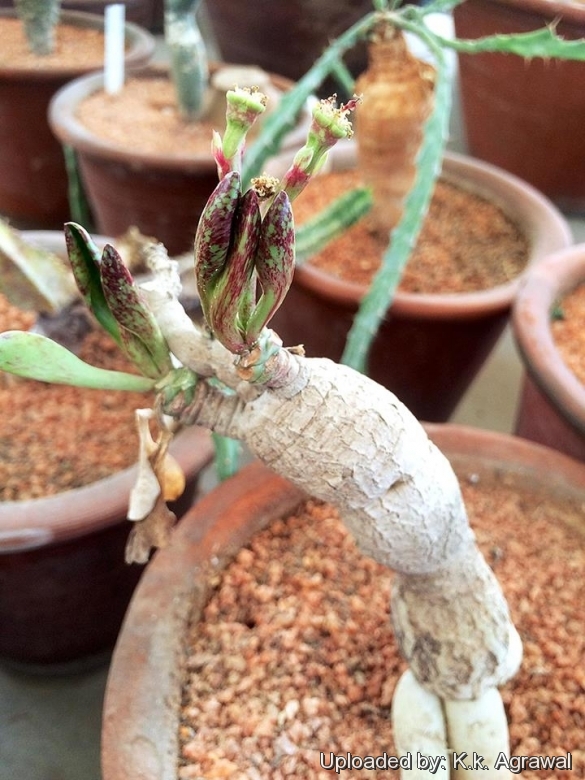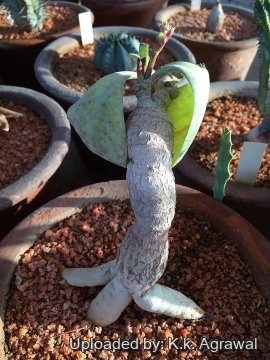
Euphorbia fusiformis var. khandallensis Photo by: K.k. Agrawal
New leaf and flower.
Origin and Habitat: India (Western Ghats). The type specimen was collected by McCann in Khandala in 1918
Altitude range: Around 500 metres above sea level.
Habitat and ecology: The typical locality is an exposed rocky ground, where plants are subject to rather hard climatic conditions throughout the year.
Synonyms:
See all synonyms of Euphorbia fusiformis
back
Accepted name in llifle Database:Euphorbia fusiformis var. khandallensis (Blatt. & Hallb.) Binojk. & N.P.Balakr.Fam. Euphorbiaceae India 62. 1825 [26 Jan-1 Feb 1825]Synonymy: 2
Accepted name in llifle Database:Euphorbia fusiformis Buch.-Ham. ex D.DonProdr. Fl. Nepal. 62. 1825 [26 Jan-1 Feb 1825]
back
Description: Euphorbia fusiformis var. khandallensis (formerly Euphorbia khandallensisSN|31729]]SN|31729]]) is a geophyte, polymorphic dwarf species similar to Euphorbia acaulis. It forms a substantial rootstock (caudex) that can grow to about 40 cm long and 10 centimetres in diameter, the whole aboveground plant to 15 centimetres height. The green and purplish leaves are very attractive, appear during rains and fall off soon after they cease. The leaves are followed by a purplish inflorescence. The shape and size of the bracts is the feature most readily separating this plant from E. acaulis.
Derivation of specific name: 'khandallensis' For the occurrence near Khandalla, India.
Rootstock: Up to 40(-70) cm long, 10-20 cm in diameter, simple or sparingly branched, completely covered underground.
Stems: Few, below ground, usually less than 2 cm long.
Leaves: Radical (spreading at ground-level), fleshy, oblanceolate, up to 33 cm long and 11 cm wide (but usually smaller), entire, green, yellow to red-variegated, petiole to 5 cm long.
Inflorescence: Coming out soon after leaf fall, generally purplish, at times green in colour, up to 14(-18) cm long and about 10 cm broad, with peduncles to 9 cm long. The lower bracts broadly triangular, as broad as or broader than long to 6 mm long, purplish; higher bracts broadly ovate or suborbicular, abruptly acuminate. Cymes 4- to 5-forked, rays to 15 mm long.
Flowers (Cynthia): Approx 6 mm in diameter, reddish; nectar-glands oblong, purplish, touching.
Blooming season (in habitat): The species flowers and set fruits abundantly during February to April.
Fruits: Obtusely lobed, 4x8 mm. Pedicels to 12 mm long, recurved.
Seeds: Globose, 3 mm in diameter.
Subspecies, varieties, forms and cultivars of plants belonging to the Euphorbia fusiformis group
Bibliography: Major references and further lectures
1) Umberto Quattrocchi “CRC World Dictionary of Medicinal and Poisonous Plants: Common Names, Scientific Names, Eponyms, Synonyms, and Etymology”(5 Volume Set) CRC Press, 03 May 2012
2) J. Indian Bot. 2: 48. 1921, "Fam. Euphorbiaceae India" 280. 2007
3) “Records of the Botanical Survey of India” Volume 16 Office of Superintendent of Government Print., India, 1953
4) Urs Eggli, Leonard E. Newton “Etymological Dictionary of Succulent Plant Names” Springer Science & Business Media, 29 June 2013
5) Urs Eggli “Illustrated Handbook of Succulent Plants: Dicotyledons” Volume 2. Springer, 2002
 Euphorbia fusiformis var. khandallensis Photo by: K.k. Agrawal
Euphorbia fusiformis var. khandallensis Photo by: K.k. AgrawalSend a photo of this plant.The gallery now contains thousands of pictures, however it is possible to do even more. We are, of course, seeking photos of species not yet shown in the gallery but not only that, we are also looking for better pictures than those already present.
Read More... Cultivation and Propagation: Euphorbia fusiformisSN|31727]]SN|31727]] var. khandallensis is an interesting addition to a collection, but rarely seen in cultivation.
Growth rate: It grows well, though very slowly, but it possible to increase the speed of growth to some extent by providing adequate amount of water, warmth, and fertilizer during the active growing season, but it’s susceptible to rotting if too wet.
Exposure: It needs light shade, but the caudex should be in the shade, while the leaves prefer some sun. Avoid direct blasting sun in summer. Bright light if grown indoors.
Caudex exposure: The remarkable tuberous rootstock (caudex) is often raised above the soil line so that this can be seen and more readily appreciated. For best results the tuber must be exposed only when plans become mature enough, usually after several years (8-12 or more years) of underground growth, as the exposed caudex will no longer increase in size once it has been lifted above the soil line.
Soil: In pots it needs a very porous potting medium (add pumice, vulcanite, and perlite). It does better in a rather acidic soil.
Waterings: Water frequently while plant is in full growth, but keep dry during the winter after the branches have died back. It rot easily and do NOT like a lot of water when it has no leaves.
Fertilizer: Benefits from moderate doses of a well-balanced, slow-release fertilizer.
Frost tolerance: Due to its Indian origin keep warm in winter, the minimum safe average temperature is 15°C, although it can go lower for short periods. It can be grown outdoors in frost-free climates, need anyway to kept above 10°C and dry in winter. It is very prone to rot in cool, wet conditions. USDA Zone 10-12, but does very well in containers.
Maintenance: Repot every two years. It like pots with generous drain holes.
Pest and diseases: White meldew, mould and other fungi.
Veterinary medicine: The latex is used as medicine for eye troubles in buffaloes.
Propagation: The species can be propagated by both seeds and cuttings. The plants for seed production are generally grown from cuttings since these bloom more freely. The plants for decoration are grown from seed since they develop a caudex.












